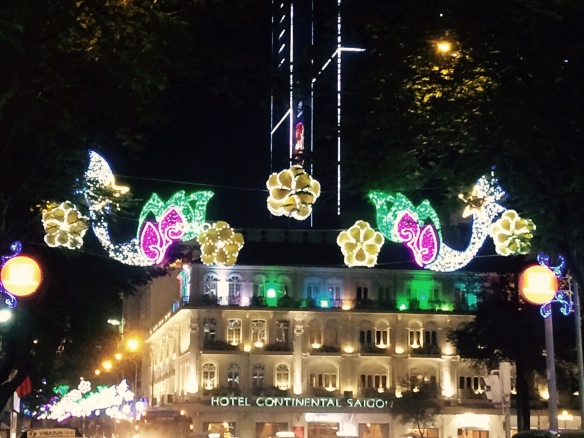
The Old Hotel Continental, the mainstay and watering hole for journalists and diplomats during the Vietnamese War.
I was 10 when my family left Saigon in mid-1962. For me, Saigon and Vietnam had been home for 4 years, a pretty significant chunk of my childhood. During our four years there, we’d lived through at least two coups and several rebel skirmishes; I’d seen bombings — been in bombings — my father had been shot in the neck & nearly killed during one coup; tanks or jeeps with mounted light artillery seemed to be on every corner, every day. During a lull in the fighting during one coup, I escaped our house, tired of crawling on all fours for 3 days so we wouldn’t accidentally get shot, and instead, climbed up our 20 ft. water tower to check out the fighting. It wasn’t pretty, out in the streets. What I saw served to squelch any rebellious curiosity and I stayed in the house, crawling around on all fours until the revolt was over.
And, this was all before there was a “real” war in Vietnam, before American troops openly were deployed by the thousands to fight the North Vietnamese Communists.
Fifty-three years after leaving, I returned to Vietnam for the first time. My husband was afraid I’d have a lot of negative flashbacks; whatever anxieties I had were over by the time we landed in Saigon.
First & foremost, no one called the city by its “official” name of Ho Chi Minh City. It seems the southerners are stubborn in retaining the old name, although we found even in Hanoi and the far north, the Vietnamese called HCMC Saigon.
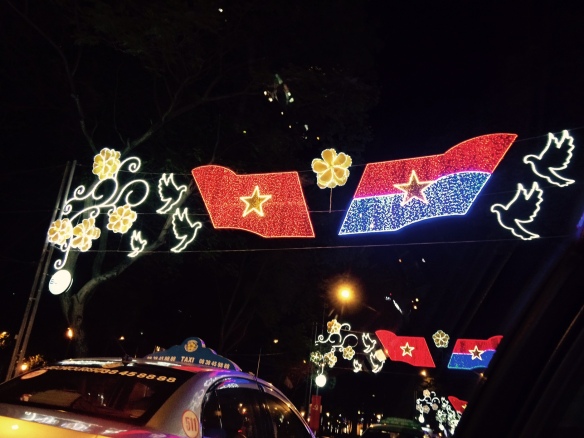
Downtown Saigon — banners every 50 feet proclaimed the triumph of Communism and the upcoming Tet celebrations.
Obviously, much had changed: Saigon was a modern, if developing, city. Thousands of motorbikes had replaced bicycles & cyclos (bicycle-propelled 2 seater buggies). Dozens of sky scrapers dwarfed some of the old areas and historical hotels and buildings. And everywhere — despite all the incredible and crafty entrepreneurship — were reminders that Vietnam was solidly a communist country.
First, 2015 was the 80th anniversary of the establishment of the Communist Party in Vietnam, as displayed on the banner below.
Secondly, year-long 2015 was celebrated as the 40th year since the fall of Saigon in April, 1975, and the Communist Party could lay claim to the entire country.
Lastly, all of Vietnam was gearing up for THE major national holiday, Tet, the Lunar New Year. So, the streets streamed banners and strands of colorful lights, and the city hummed with anticipation.
We had a private guide and driver and thus the inescapable, crushing, cacophonous traffic was sub-bearable, as opposed to overwhelming. No one paid attention to stop lights or designated lanes. To cross a street, you held up your hand in the universal “stop” signal and waded in among the thousands of motorbikes, taxis and cars. It didn’t matter if you were at a corner or the middle of the street. In fact, stepping off a corner was far, far more dangerous as kamikaze bikers swooped and screeched around corners at full speed.
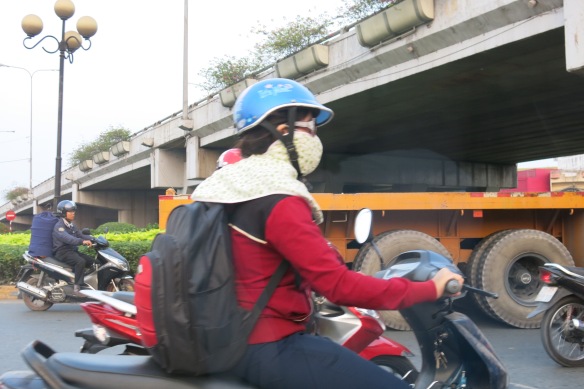
Most commuters wore masks or scarves wrapped tightly around their faces to ward off the persistent smog and bike exhaust. Many women also wore gloves and socks along with long sleeves to keep their skin from darkening.
We found that many Vietnamese, especially women, were fanatic about protecting their skin, as fair skin tone is very prized. We actually found this prejudice for fair skin pervasive among both men and women, as both sexes strove for skin as fair as one could achieve it, often chemically. (Billboards all over Saigon advertised facial whitening creams and treatments.) We had a couple of male guides tell us they would not marry a dark-skinned woman, the thought was just too repulsive to them.
I did recall this love affair with fair skin even as a child, but paid it no mind, except for one encounter when I was about seven. We were boating with another family in the northern part of South Vietnam, and the father of the boat captain, an elderly Vietnamese, had never seen a child with platinum blonde hair and very pale skin. Unsurprisingly, he wanted to touch my hair and face to see if I was real, and, of course, I freaked. My father came to the rescue and resolved the situation without causing a diplomatic incident, but I had to tolerate a lot of hair petting and arm examination the first couple of years there.
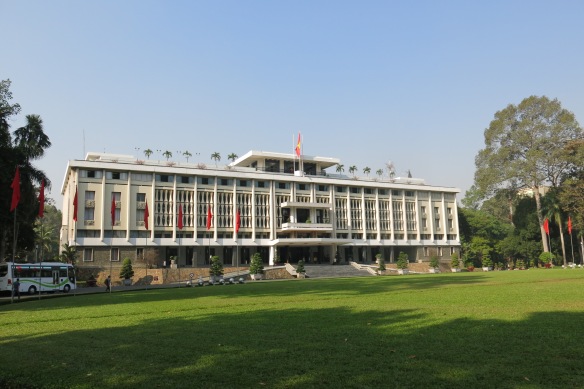
The former Presidential Palace, now the Reunification Palace. Enter a caption
In addition to seeing a lot of temples, our lovely guide, Hoa, made sure I saw some of the buildings that remained from my childhood. The old Presidential Palace was gone, destroyed by bombs while we were there, and the mid-60’s constructed replacement is now the Reunification Palace. It was amazing that so many of the old landmarks had survived the coups & revolts, the bombs and shellings that Saigon suffered through. A few, for the memories:
 Notre Dame Cathedral, with a few of Saigon’s newer buildings in the background.
Notre Dame Cathedral, with a few of Saigon’s newer buildings in the background.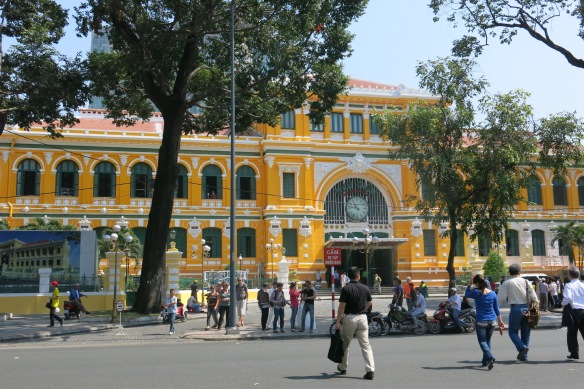
The Old Post Office
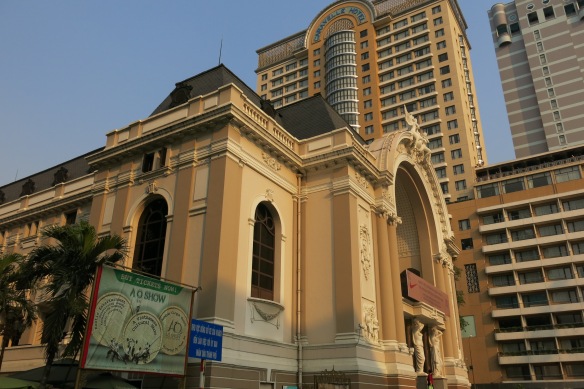
The still-elegant Opera House, where Michael and I attended a cultural performance.
I’ve alluded to temples, and will cover some of those in a later posts, hopefully, along with photos from other parts of Vietnam.
But one place we saw held such a special meaning for me, the beautiful house my family had lived in for four years. Through the determination of our guide and driver, and despite several street name changes over 50 years, we found “my” house. I was quite surprised, because so many of the old colonial style houses had been torn down or converted into unattractive apartments. Ours had not — it was even more beautiful than I remember; obviously someone had chosen to restore the house itself, probably 100 years old at this point, and also beautifully landscaped the yard.
Like most diplomats, we had rented a house that had belonged to a French colonial who’d given up on Vietnam and returned to France. Like all such foreigners’ or ranking Vietnamese houses, the house was enclosed by a tall wall and a locked gate. Our guide would not be deterred, and long story short, she talked us past the locked gate about 10 feet. Stunned and unashamedly overwhelmed to be seeing “my house” again, I flubbed half of the pictures I took, but here are two:
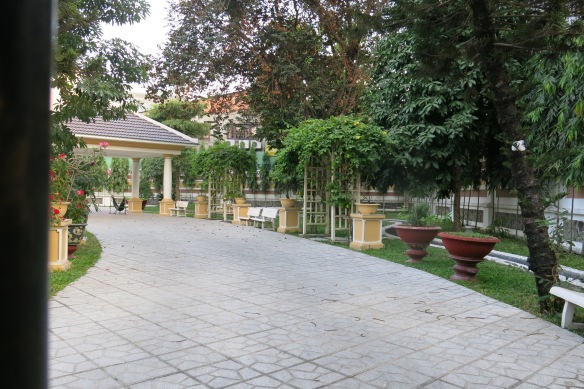
The driveway leading from the gate to the portico; the main house stands to the left.
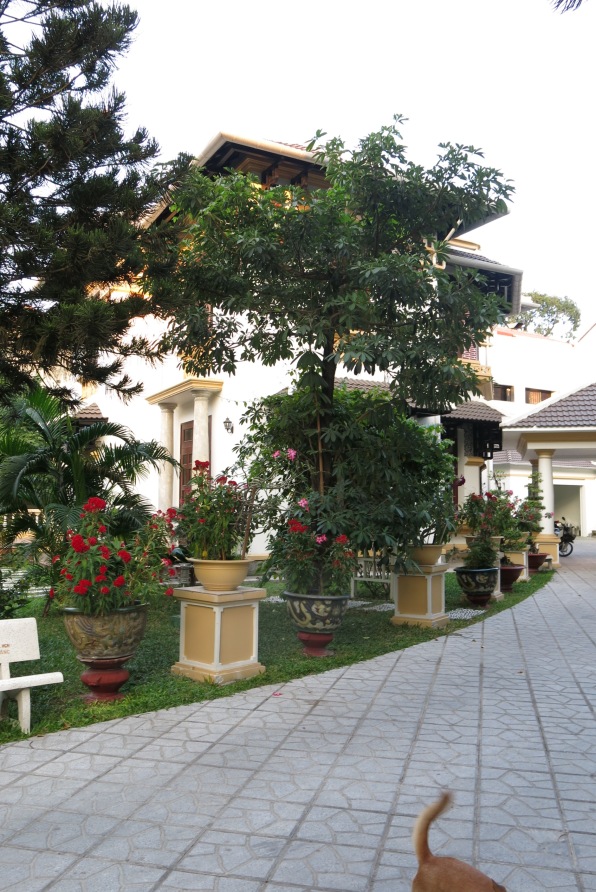
The stucco was new, as the shutters over the huge windows, and the grounds beautifully landscaped. The renovations were meant to ensure privacy, with views into the house blocked by both a high wall and these tall trees inside the wall & gate.
As it turned out, ironically, the entity that had expensively restored the house and grounds was the Communist Party of Vietnam, and one of their high-up officials now lived in our old house in relative luxury. How things do change!
There were three aspects of “modern” Saigon that I noted were entirely new in this new century. The first was the incredible amount of air pollution, mostly from vehicular traffic. There are millions of motorbikes in the Saigon area.
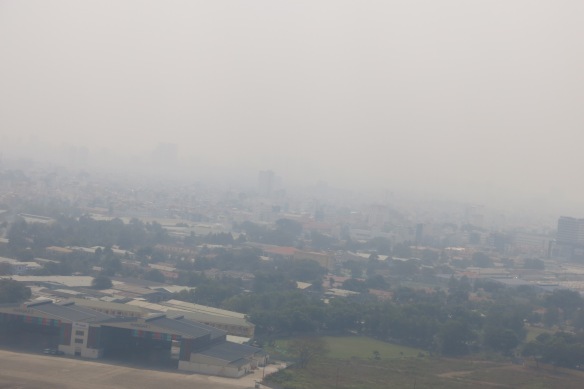
From the air: a blanket of smog between the airport and very nearby downtown Saigon obscures the buildings of the city.
The other two observations were interesting, if not whimsically more appealing.

One of the recently built skyscraper in downtown Saigon, a beautiful and unusual building. Note the round platform projecting out of the building: a helipad. Business in the 21st. century!
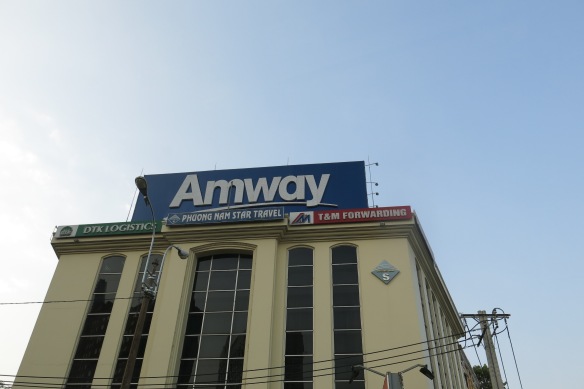
And, finally, Amway comes to Vietnam.
Amway in Vietnam. Who’d have thunk it? Communist country or not, the Vietnamese definitely have the entrepreneurial spirit!
This first stop back in Vietnam held several surprises for me: the physical growth, the ubiquitous air pollution, the energy of Saigon. Two other aspects struck me: how happy — genuinely happy — people seemed to meet Americans, and how friendly so many of the people were. During our 2+ weeks in Vietnam, I came to realize that for the Vietnamese, the “American War” as they call it was a small blip in the overall history of the Vietnamese people. And while we were shown kindness and assistance by many people on our trip (outside of our guides and drivers) it clearly is the younger people, those under 30, who hold a deep fascination for all things Western or American. Still, along with the drive to modernize and even Westernize, the people we met also demonstrated a deep and satisfied pride in their own very ancient culture.
![]()

Carol Barbier Rolnick grew up in Japan and Southeast Asia, traveling extensively as a child through Asia, the Mideast and Europe on family vacations. Travel has continued as a priority through raising kids and continuing into retirement, extending adventures through the Americas, southern Africa, Asia, and repeat trips throughout Europe. Carol and her husband, Michael spent four summers based in Utrecht, The Netherlands, which has become like a second home. They are (still) aiming towards Australia-New Zealand and Antarctica to round off their continental travels.








